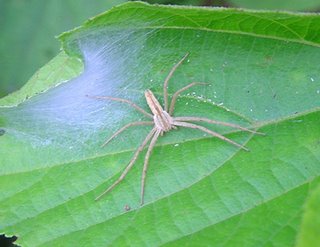Elongated philodromid spider | Tibellus elongatus
Tibellus elongatus Tikader, 1960 (Family: Philodromidae)
Common name: Elongated philodromid spider
Size: Female: 8-10 mm, Male: 4-6 mm
Distribution: India
Family Identification features: Cephalothorax slightly flattened, as long as wide or elongated and smoothly convex on lateral sides, clothed in soft recumbent setae, white to pale cream and reddish brown or greyish brown in colour, frequently mottled with longitudinal bands or chevrons. Eight eyes in two rows, both eye rows recurved, sometimes posterior row strongly recurved. Apex of sternum with an obtuse point between coxae IV. Labium slightly longer than wide. Chelicerae usually without teeth. Legs slender, laterigrade, with two claws and semi-erect or recumbent spines; femora I without cluster of erect spines; legs I, III and IV almost equal in length, leg II usually longer, sometimes much longer; tarsi I and II with scopulae and claw tufts. Abdomen oval or elongated, covered with soft recumbent setae; usually with a dark, heart shaped mark and a series of chevrons. Spinnerets simple, colulus absent. Epigyne complex, small, usually with median septum, sometimes with folds and copulatory openings on the laterals; spermatheca kidney shaped. Male palp with small apophysis on tibia, embolus long to short, slender and arched at the distal end of tegulum. A total of 43 species of 7 genera are reported from India so far.
Species description: Cephalothorax yellowish, with a mid-dorsal darker band; on either side of mid dorsal band, an inconspicuous lateral band present; longer than broad, abruptly narrowed from posterior lateral eyes forwards; clypeus bears many long bristle like hairs. Posterior eye row recurved, posterior medians and posterior laterals separated by a distance more than the distance between posterior medians. Anterior eye row recurved, subequally spaced; posterior medians and eyes of anterior eye row give an impression of a hexagon. Posterior laterals larger than posterior medians. Chelicerae yellowish, outer face with dark brown spots, outer margin with two teeth, inner margin toothless, fang reddish, much shorter, reaching only up to second teeth. Sternum yellowish, broadest at coxae II, tapering at III, IV also slightly narrower at coxae I. Legs long, yellowish; ventrum of tarsi and metatarsi I and II with short scopulae like hairs; leg formula 2143. Abdomen yellowish, slender, cardiac region dark brown, mid-longitudinal band broader in the anterior end and tapering to a narrow line in the posterior half. Two black spots in the posterior half, a little above posterior end a median black spot present on the median dorsal band. Ventrum yellowish, lighter than dorsum, without dark makings. Epigyne with two reddish brown sclerotised lateral pieces enclosing a median cavity.

Natural History: This spider closely resembling the family Thomisidae in terms of erratic movements and laterigrade legs. These are free-living hunters commonly found on plants. Their movements are erratic and using their claw tufts and scopulae, they are able to move swiftly. Their elongated, straw-coloured bodies with dark longitudinal lines, as well as their posture, render them inconspicuous on dry grass. The female makes egg sacs on the folded grass leaf.
Contributed By : Sudhikumar A.V.


0 Comments:
Post a Comment
<< Home